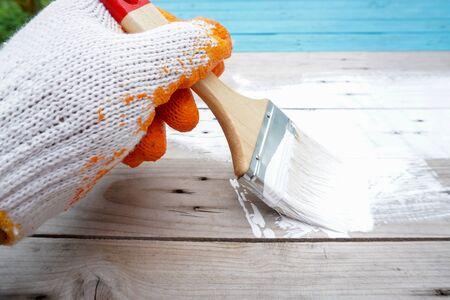Understanding the Impact of Weather on Painting Projects
When it comes to painting your home or business, weather isn’t just a background factor—it’s a crucial player in the final look and longevity of your paint job. In the U.S., where seasonal weather shifts can be dramatic, understanding how temperature, humidity, and sunlight affect both paint application and durability is key. Extreme temperatures, whether hot or cold, can cause paint to dry too quickly or not at all, leading to uneven coats or peeling down the road. High humidity can trap moisture under the paint surface, which may result in bubbling and poor adhesion. On the flip side, painting during dry, sunny conditions might seem ideal, but direct sunlight can actually cause paint to dry too fast, making brush marks more visible and reducing your working time. Timing your project according to local weather forecasts isn’t just about avoiding inconvenience—it’s a smart move that helps you avoid costly do-overs and extends the life of your investment. By planning ahead and choosing the optimal season for your painting project, you set yourself up for professional-looking results that stand up to time and the elements.
Spring and Summer Painting: Maximizing Favorable Conditions
When it comes to painting exteriors or interiors, spring and summer offer prime conditions for achieving a flawless finish. But to truly capitalize on the warmer months, you need more than just sunshine—you need a game plan that blends proven techniques with practical know-how.
Ideal Temperature and Weather Windows
Not all warm days are created equal. The sweet spot for most paints (both latex and oil-based) is between 50°F and 85°F, with humidity levels below 70%. Too hot or too humid? Your paint can dry too quickly, leading to brush marks, blistering, or uneven coverage. Too cold? The paint won’t cure properly, risking peeling or cracking down the road.
| Paint Type | Ideal Temperature Range | Best Time of Day |
|---|---|---|
| Latex (Water-Based) | 50°F–85°F | Morning or late afternoon |
| Oil-Based | 40°F–90°F | Midday (if not too hot) |
Surface Prep: Set Yourself Up for Success
The right prep work is non-negotiable if you want results that last through the seasons. Clean surfaces thoroughly—remove dirt, pollen, mildew, and loose paint. For exteriors, pressure washing followed by a day of drying works wonders. Repair any cracks or holes before priming; this will help your paint adhere and increase your return on investment by extending the life of your work.
Avoiding Common Warm-Weather Pitfalls
- Blistering: Never paint in direct sunlight or on super-hot surfaces; wait until the area is shaded and cool to the touch.
- Fading: Use high-quality, UV-resistant paints for exterior projects—cheaper paints may save money up front but can fade fast under strong sun.
- Tacky Finish: High humidity can prevent proper curing; try painting when humidity drops below 70% for best results.
- Mismatched Sheen: Always mix multiple cans together (“boxing”) before starting to ensure color consistency throughout your project.
Pro Tip: Timing Is Everything
If you’re painting outside, start early in the morning or later in the afternoon to avoid peak heat. Indoors, keep windows open for airflow but avoid strong cross breezes that can cause dust to settle on wet surfaces. With these strategies, you’ll maximize both efficiency and the long-term value of your painting investment during spring and summer.

3. Fall Painting: Catching the Last Warm Days
As summer fades and crisp air rolls in, fall presents a golden window for exterior painting—if you know how to make the most of it. Extending your painting season safely into autumn requires strategic timing, awareness of shifting weather patterns, and a focus on long-lasting results before winter arrives.
Monitor Temperatures and Timing
In many U.S. regions, early fall offers daytime temperatures that are still paint-friendly, typically between 50°F and 85°F. Nights can cool down quickly, so check both daily highs and overnight lows; most latex paints need temps above 35-50°F for at least 24 hours to cure properly. Start your projects in late morning to allow any dew to evaporate, and plan to finish with enough daylight for drying.
Watch Out for Weather Swings
Fall is notorious for unpredictable rain and wind. Always monitor local forecasts and avoid painting if rain or frost is expected within the next 24-48 hours. Windy days can blow debris onto wet surfaces or cause uneven drying, so aim for calm conditions whenever possible. A little preparation helps you avoid wasted time and ruined finishes.
Choose the Right Paint Products
Select paints labeled as “all-season” or “cold weather” formulas if you’re pushing into late fall. These products are engineered to cure at lower temperatures and resist moisture better than standard blends. Investing in quality paint may cost more upfront but pays off by preventing peeling or cracking during harsh winter months.
Prep Surfaces Thoroughly
Falling leaves, dust, and pollen can stick to surfaces or get trapped under new paint layers. Clean thoroughly, scrape away old paint, and let all surfaces dry completely before applying fresh coats. This extra attention ensures a smooth, professional-looking result that lasts beyond the season.
Maximize Curb Appeal—and Value
A well-timed fall painting job doesn’t just protect your property; it enhances curb appeal right before the holiday season or winter listing rush. By managing weather risks and using pro-level techniques, you’ll lock in a sharp look and safeguard your investment through the colder months ahead.
4. Winter Painting: Can It Be Done?
If you’re eyeing a winter painting project, you’re probably wondering if it’s really possible to get professional results when the mercury drops. The short answer: Yes, but with caution and the right approach. While traditional paint products may struggle in cold conditions, modern advancements have brought specialized formulas that make cold-weather painting feasible for both interiors and exteriors.
Understanding Temperature Thresholds
Paint performance is highly sensitive to temperature. Most standard latex or oil-based paints recommend application at temperatures above 50°F (10°C). However, many manufacturers now offer “low-temp” or “cold-weather” paints designed for use in conditions as low as 35°F (1.7°C).
| Product Type | Minimum Application Temp | Ideal Use Case |
|---|---|---|
| Standard Latex Paint | 50°F (10°C) | Spring/Summer, controlled indoor environments |
| Low-Temp Acrylic Paint | 35°F (1.7°C) | Exterior/interior winter projects |
| Oil-Based Paint | 40°F (4.4°C) | Trim, metal, special projects in mild winter climates |
Best Practices for Winter Painting Success
- Monitor Weather Patterns: Always check the forecast for at least 48 hours after application—paint needs time to cure without freezing temperatures or precipitation.
- Prep Surfaces Thoroughly: Cold air increases surface condensation; ensure surfaces are dry and free from ice or frost before you start.
- Select Specialized Products: Look for paints labeled “winter formula,” “low-temp,” or “cold-weather.” These contain additives that prevent thickening and help with adhesion.
- Allow Extra Dry Time: In winter, drying and curing times can double or triple compared to warmer months.
- Avoid Evening Applications: Temperatures tend to drop sharply after sunset, which can compromise the finish quality and durability.
The Investment Payoff: Why Timing Matters
Your timing has a direct impact on your project’s long-term ROI. Properly applied winter-specific paint resists cracking, peeling, and moisture intrusion better than standard formulas forced into service out-of-season. Cutting corners here often leads to costly touch-ups or full repaints within a year or two—negating any perceived time savings. For homeowners and real estate investors alike, understanding these cold-weather techniques protects your property value and ensures lasting curb appeal even through harsh winters.
5. Weather-Proof Painting Products and Tools
If you want your paint jobs to withstand the test of time—and the unpredictability of American weather—selecting the right products and tools is non-negotiable. Whether you’re a homeowner aiming to protect your investment or a contractor focused on reducing costly callbacks, using weather-adapted supplies is your best bet for maximizing ROI.
Paints Engineered for Every Season
Choose paints labeled as “all-weather” or “seasonal formula.” These products are designed to flex with temperature changes, resist moisture, and prevent premature fading or cracking. Acrylic latex paints work exceptionally well in most U.S. climates, offering strong adhesion and flexibility. For regions with extreme humidity or rainfall—think the Southeast or Pacific Northwest—opt for mildew-resistant exterior paints.
Primers That Power Performance
The right primer can make or break your project’s longevity. In colder climates, look for primers rated for low-temperature application (as low as 35°F). For hot, sunny states like Arizona or Texas, UV-resistant primers help maintain color and finish integrity. Always choose oil-based primers for surfaces prone to tannin bleed (like cedar) or high-moisture environments.
Essential Gear for Smart Application
Your tool selection matters just as much as your paint. Invest in high-quality synthetic brushes and rollers designed for smooth coverage in both damp and dry conditions. If painting during windy or variable weather, an airless sprayer with adjustable pressure will help control overspray and deliver even coats. For unpredictable weather windows, keep tarps and quick-dry additives handy to protect surfaces if rain threatens before the job is done.
By upgrading to weather-proof paints, primers, and tools tailored to your local climate, you’ll ensure fewer touch-ups, happier clients, and a stronger return on every painting project—no matter what Mother Nature throws your way.
6. Scheduling and Budgeting Your Painting Project for Maximum ROI
When planning a painting project, especially in the U.S. where weather can vary dramatically by region and season, timing is everything if you want to maximize your return on investment (ROI). Start by mapping out the local weather patterns: check average temperatures, humidity levels, and rainfall forecasts for your area. Painting during optimal seasonal windows—like spring or early fall in most states—ensures better paint adhesion and drying, ultimately boosting the longevity of your paint job.
Next, strategize your budget with both labor and material costs in mind. Prices for both can fluctuate depending on demand; for example, hiring professional painters during peak season often costs more. Book contractors well in advance during off-peak months to score better rates without sacrificing quality. If youre going the DIY route, buy materials ahead of time when retailers are offering promotions or clearance discounts at the end of the painting season.
Don’t forget to factor in weather-related delays or prep work—such as extra priming or longer drying times due to humidity—which could extend your timeline and increase expenses. Build a buffer into both your schedule and budget for unexpected changes so your project doesn’t stall or go overboard financially.
Finally, remember that a well-timed, professionally executed paint job isn’t just about curb appeal—it’s a smart investment. Fresh paint protects surfaces from weather damage and boosts property value, delivering solid ROI whether you’re looking to sell or simply maintain your home. By aligning your project’s timing and budgeting with real-world weather conditions, you’re setting yourself up for long-term savings and a higher-quality finish that stands the test of time.

